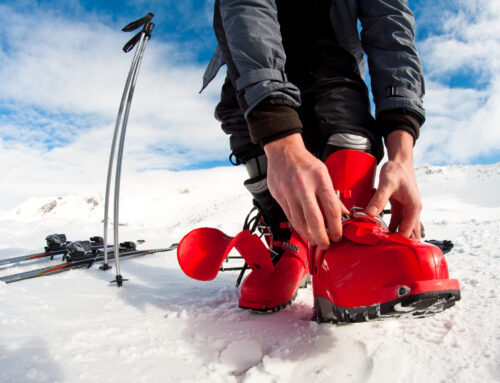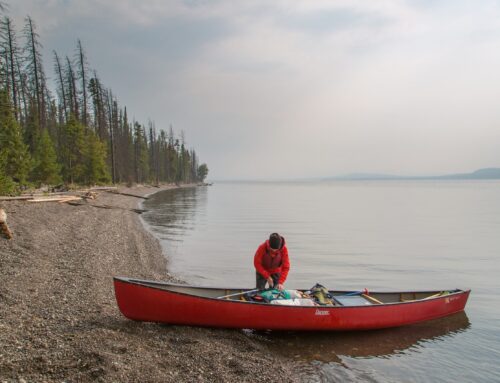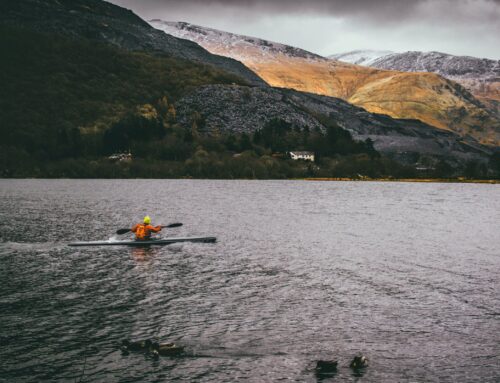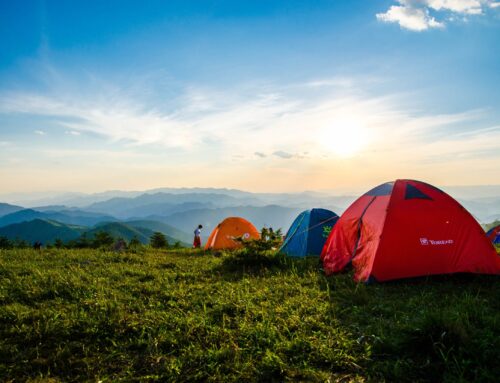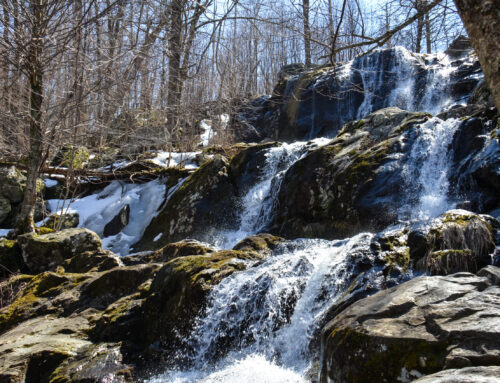Updated July 15, 2022
It’s no secret that more and more people are finding enjoyment in the outdoors. With more foot traffic and human interaction with the wilderness comes an increased risk of damage to the environment and its natural ecosystems. As people flock to nearby trails and nature areas, it’s critical to learn strategies for protecting and preserving our wild spaces…which is where Leave No Trace comes in.
You may have heard of Leave No Trace as a philosophy, an organization, a course, or something else. It’s all of these things and more. From our perspective, Leave No Trace is a mindset and a tool. In this guide, we introduce Leave No Trace and explain the basics of the Seven Principles, which can help us all become better stewards for conservation and sustainable recreation.
What Is Leave No Trace?
Coined by an educational nonprofit with the same name, Leave No Trace’s Seven Principles were created to inform the public how to recreate sustainably in public lands. Today, the Principles serve as a map for us to follow to protect these nature areas. They provide a blueprint for ways to think, act, and react while doing activities outdoors to protect the spaces we are all actively enjoying.
The Seven Leave No Trace Principles are:
- Plan Ahead & Prepare
- Travel & Camp on Durable Surfaces
- Dispose of Weights Properly
- Leave What You Find
- Minimize Campfire Impacts
- Respect Wildlife
- Be Considerate of Others

Why Do We Need Leave No Trace?
Raise your hand if you’ve ever seen trash on a hiking trail, or in a river you’re paddling through. Or if you’ve seen news coverage on rampant wildfires and wildlife affected by pollution. Or if you’ve felt like a trail was overcrowded and cramped.
If you’ve been outside lately, you’ve probably raised your hand for at least one of these things.
Leave No Trace addresses many of these issues and more. Instead of governments and organizations having to fund restoration and repairs of public trails and waterways, Leave No Trace takes a preventative approach to conserving wild spaces and ensuring that outdoor participants are using lands sustainably. We need Leave No Trace and its principles to educate the masses about the effects of human activities on natural spaces, and how we can mitigate those effects through some very simple, effective actions.
The Seven Leave No Trace Principles, Explained
Plan Ahead & Prepare
The first step before embarking on any outdoor adventure is to plan ahead and prepare. While this may seem self-explanatory, you might be surprised at the number of park rangers and other hikers who have met people who are heinously underprepared for a specific hike or activity. Lack of preparation and knowledge can lead to some pretty scary outcomes, including potentially getting lost or injured.
Planning ahead can take several forms, all of which you should consider before embarking on any outdoor adventure:
- Are you aware of the terrain and distance of your expected activity?
- Do you have the right equipment?
- What maps and resources do you have available? How will you get around?
- What will the weather be like? Will it pose a threat to your safety?
- Do your own skills and abilities match up with the requirements of the excursion?
- Do you understand the risks of this activity? What is your backup plan if something goes wrong?
- Are you carrying a first aid kit for minor injuries?
Of course, there’s no need to bring all of your belongings or over-plan to the point of cancelling your trip. But preparing fully for your adventure will help to keep you and your environment safe.

Travel & Camp on Durable Surfaces
For those recreating on land, you can protect nature areas by always traveling & camping on durable surfaces. In plain English, this means that you should only set foot on areas that can withstand human foot traffic. Trails and established campsites are typically a great place to start. However, things can get a little more seedy when you need to head off-trail to use the bathroom or go camping in the backcountry.
When there isn’t a specified trail, there are a few guidelines you can follow. Sand, gravel, and rock are typically durable and are fair game for hiking. Ice and snow can also be decently durable, but should be traveled with the right gear and extreme care. Vegetation, “living soil,” and desert mud holes are usually places to avoid stepping if at all possible, as disruption to these ecosystems can result in permanent damage of the organisms living there.
Camping is a slightly different story. When camping in the frontcountry, only use established campsites and avoid setting up camp in undesignated areas. This condenses all of the trampling activity to very specific areas and allows ecosystems to thrive in non-campsite areas.
In the backcountry, the name of the game is minimizing activity and foot traffic. First of all, along with Principle #1, you should not go backcountry camping unless you have thoroughly prepared and planned your itinerary. The best places to set up camp in the backcountry are sites that were previously used, so you can minimize impact in undisturbed areas.
While camping, take as few trips as possible across vegetation, keeping all necessary foot traffic to sand, gravel, and stone. Additionally, do not camp closer than 200 feet from a water source, and be sure to move camp every 1-2 nights so your impacts are less severe on the local ecosystems. You can find a more detailed description and guidelines for traveling and camping on the Leave No Trace website.
Dispose of Waste Properly
Waste from human activities can be a huge source of pollution on trails, in forests, and in waterways. It’s important to dispose of waste properly when recreating in nature areas. This may be the most common principle people think of when they hear “Leave No Trace.” From trash to waste water, waste on the trails can come in many forms and must be disposed of properly to avoid interference with local plant and animal species. We’ll cover the basics of common types of waste, but if you want the full Leave No Trace lowdown, you can check it out here.
When in Doubt, Pack It Out
If you aren’t sure where to begin with disposing waste on the trail, follow the mantra of “when in doubt, pack it out.” All trash, food, and gear items should be taken with you and disposed of in a proper trash receptacle. Even food scraps and biodegradable items should be packed out with you. It’s easiest to bring a small plastic bag or a reusable trash sack to carry out disposable items while you’re on the trail.
Using the Bathroom
Using the bathroom may be an icky subject, but it’s an important part of the Leave No Trace principles. In short, you can’t just poop or pee anywhere and everywhere outside.
To poop outdoors, Leave No Trace recommends digging a cat hole. In essence, a cat hole should be in a soil or dirt area without much foot traffic. Bring a portable trowel and dig a hole 6-8 inches deep (4-6 inches in the desert). Do your business and cover the hole with the displaced dirt and other native materials.
Urinating is a little easier to manage, as it doesn’t do much damage to vegetation. It can, however, attract animals to its scent, so it’s best to dilute the area with water when possible. Pack out toilet paper and sanitary products like you would any other trash, or use “natural” toilet paper – leaves, snow, rocks – when possible and bury it in the cat hole.
Wastewater
Bathing, dishwashing, and laundry can create “gray” wastewater that also needs to be disposed of properly. Washing should always be done over 200 feet away from any waterways, including streams, rivers, and lakes. You should always strain dirty dishwasher to collect food scraps and pack those out, before disposing of the wastewater. In general, when washing, minimize use of soaps and liquids, even biodegradable ones, as they can affect waterways.

Leave What You Find
Although it may be tempting to take souvenirs from your hikes and adventures, the fourth principle is to leave what you find. Yup, this is as simple as it sounds: look with your eyes, and not with your fingers. This means leaving interesting objects where you found them and not defacing trees, stones, or other artifacts. Don’t pick flowers, don’t steal seashells, don’t take a leaf or a rock or a branch to-go. Admire it, enjoy it, and then move on.
When I talk to people about this, I’m usually met with something like, “well, I’m just one person, what difference does it make?” Sure, it wouldn’t make a huge difference if just one person did it one time. But lasting impact comes from this mentality repeated over and over again, across hundreds of thousands of people. Leave all of the beautiful things you find for everyone to enjoy, and you’ll be doing the environment a favor, too.
Minimize Campfire Impacts
Campfires can cause a huge impact on natural environments, and minimizing campfire impacts is a critical principle of Leave No Trace. When facing a decision of whether to use a campfire or a personal stove, we’d always recommend the stove. Stoves are cleaner, safer, and less wildfire-prone than a traditional campfire, and the environmental impacts of a gas-burning stove are little to none.
There may be some instances where a campfire makes sense or can be built safely, minimizing impact. In general, if you’re going to build a traditional campfire, it’s best to build a fire in an existing fire pit. When that’s not possible, build fires in areas where there will be limited damage to the backcountry. Put out all fires with water, not dirt, and ensure that there is nothing burning when you leave. Use firewood bought or provided locally, and strive to gather kindling and smaller pieces of wood from a wide area.

Respect Wildlife
If you spend enough time outdoors, you’ll be sure to stumble across some sort of wildlife. But, as with all things in nature, it’s crucial to respect wildlife and look. When around wildlife, remain quiet and calm and avoid sudden movements. Stay a safe distance – usually 2 or more school bus lengths – and do not approach animals. Moreover, under no conditions should you feed or pet wildlife. This can greatly diminish and disturb animals’ natural patterns and behaviors. Animals can also transmit diseases to humans.
While camping, be sure to store food items correctly so that animals cannot reach them, and do not keep any food inside your tent. Many front country campsites in areas with lots of wildlife have bear boxes – use them.
Be Considerate of Others
The final Leave No Trace Principle is to be considerate of others while you’re outdoors (and in general). Ultimately, this boils down to staying out of other people’s way and respecting communal spaces where there are several people nearby. Here are a few simple ways you can be considerate and polite on the trails:
- Don’t be noisy, use headphones if you want to listen to music and keep conversations to a normal level
- Leash your dogs and pick up poop, ensure your trails are dog friendly
- When possible, go to popular trails on weekdays or off-peak hours
- Follow hiking etiquette; yield to hikers who are going faster than you or who are going uphill
- Hikers should yield to horse riders and bikers should yield to horses and hikers
- If you’re going to take a break, rest off the side of the trail on durable surfaces only

More Ways You Can Get Involved With Leave No Trace
For most people, knowing and understanding the 7 Leave No Trace principles and following them as much as possible is a great start in being stewards and protectors of the land. However, if preservation of nature areas and trails strikes a chord with you, there are several ways to get even more involved with Leave No Trace:
- Donate to the Leave No Trace organization
- Attend an event or workshop
- Take a course or certification in Leave No Trace education
- Become a member of Leave No Trace
- Volunteer with Leave No Trace
- If you own a business, consider becoming a Leave No Trace partner
The more you can do, the better we all are, because we’re empowered with education and resourced needed to protect every nature space we enjoy. From city parks to backcountry campsites, all nature spaces require and appreciate our attention. By following Leave No Trace principles whenever you get outside, you’ll be extending the lifespan of these treasured spaces and the environment around them.

